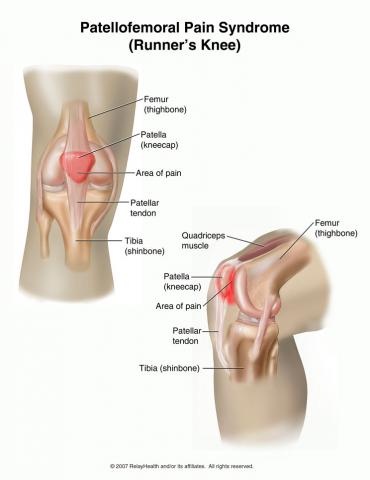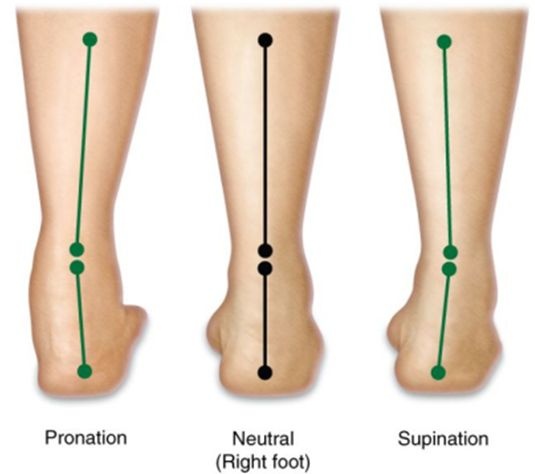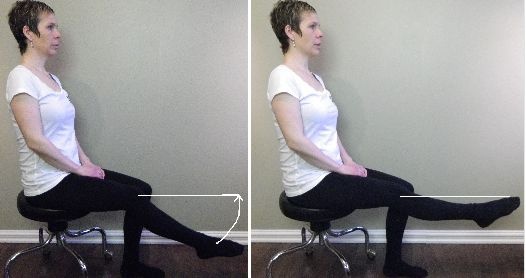Runner’s knee
Text in part from “Running Doc’s Guide”, by Dr. Lewis G. Maharam, MD.
 Runner’s knee does not happen only to runners. It is a condition with many names: chondromalacia patella, anterior knee syndrome, patella femoral disorder, and, of course runner’s knee. It is seen every day by health care providers. Understranding the real cause makes treatment easy and pain relief possible in a short period of time.
Runner’s knee does not happen only to runners. It is a condition with many names: chondromalacia patella, anterior knee syndrome, patella femoral disorder, and, of course runner’s knee. It is seen every day by health care providers. Understranding the real cause makes treatment easy and pain relief possible in a short period of time.
When it comes to runner’s knee, biology is destiny. Anyone whose foot rolls inward (overpronation) during a stride is a candidate, but the real high-risk frontrunners are people with extremely flat feet; a large, pronating forefoot; or a Morton’s foot (a foot where the second toe is longer than the first), causing an exaggerated rolling in, or pronation. Your parents gave you those feet, not your sport, your activity, or a specific injury.
Of all the aches and pains that one can get, this one’s probably the easiest to get rid of. If you were doing some serious running mileage over the summer, maybe getting ready for a fall marathon, or pain came on “all of a sudden” without any apparent injury and your knee suddenly started to get sore when you walked up and down stairs, or you felt stiff when you were sitting in a movie, you most probably have it. You could have come down with it when you were 12, or 65. And the treatment, which is not complicated or extensive, is the same for everybody from kids to grandparents.
It all starts with the kneecap. In a perfect world, your kneecap rides up and down in a V-shaped groove that sits just behind it as you walk, run or cycle. More typically, however, your foot rolls in, or pronates, as you move from heel strike to toe-off, and the kneecap ends up scraping along one side of the groove instead of sliding smoothly up and down the middle. The cartilage there doesn't much like getting sandpapered down that way, nor does the back of the kneecap, which begins to weep fluid that in turn produces a feeling of stiffness. And though runners have named the condition, it crops up often in nonathletes, as well as among cyclists and in cleated-shoe sports like soccer and baseball whose footwear can put sideways torque on the knee.
It a easy condition to diagnose: joint hurts, no particular injury caused it, worst going upstairs and downstairs or walking down an incline, stiffens after sitting a  while, feels like it needs to be stretched. That settles it.
while, feels like it needs to be stretched. That settles it.
Despite what you may have read, arthroscopic surgery is not the immediate answer. Surgery helps perhaps 1 out of 100 sufferers. One favored operation consists of mechanically smoothing the rubbing surface of the kneecap; this treatment can give relief for six months or so, but unless your biomechanics have changed, it’s a borrowed-time fix.
A proper orthotic is the single most important step because it will prevent the roll that caused the scraping in the first place. The good news is that once you start wearing the orthotic, your knee cooperates quickly; the patella, cartilage that’s been rubbed down is able to regenerate and heal itself. Just give it the chance.
But orthotics alone won’t do it. You need your other ally, the medial quad, which is the muscle in the front inside of your thigh that’s supposed to hold the kneecap in the center of the groove. The stronger your medial quad muscle is, the better it can do its job. To strengthen it, you need to perform the “terminal” leg extension exercises (see image), which limit the motion to the last 6 inches of extension. Do them daily until the pain disappears, then twice weekly. And do both legs, please, even if only one leg hurts. Your knees are a matched pair, and what’s already happened on one side is a good bet for the other someday.
Knee sleeves and elastic bandages are out. Think about it. If you compress the kneecap, every motion will press it into the groove. Keep it loose and free.
So make these exercises a part of your weekly routine, keep wearing your orthotics and you can rid yourself of this unnecessary pain forever.
Runner’s knee
Text in part from “Running Doc’s Guide”, by Dr. Lewis G. Maharam, MD.

Limited quad extensions for runner’s knee.
1. Sit up on a desk or high surface, stick your leg out straight, drop it about six inches, and if possible support it with a chair or stool. 2. Wrap your ankle with a weight bag or strap made for the purpose. 3. Lift only the last six inches (about 30 degrees) to full extension, hold for three seconds, and then come slowly back down. Do 5 sets of 10 reps each day, with just enough weight that you get to 5 or 6 on that fifth set and have to stop.



